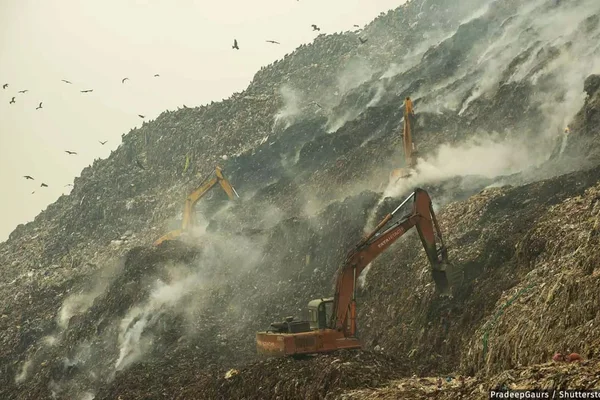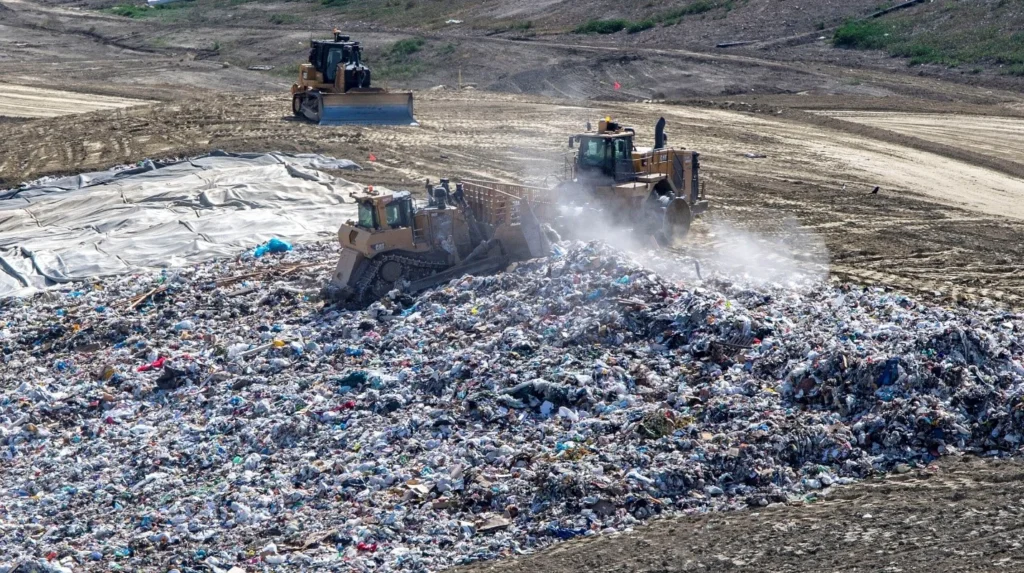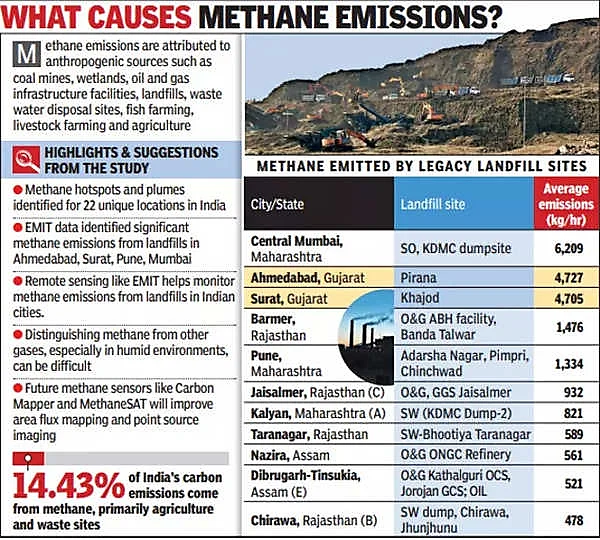A recent study by ISRO’s Indian Institute of Remote Sensing (IIRS) and National Remote Sensing Centre (NRSC) identifies significant methane hotspots in India.
Key findings:
- Overall Methane Emissions in India: Findings indicate a notable reduction in India’s net annual methane emissions from municipal solid waste landfills – from 10.84 lakh metric tons in 2015 to 4.04 lakh metric tons by 2020.
- The study identifies landfill sites in Ahmedabad and Surat as the second and third-worst methane hotspots among the top 22 in India.
- Sewage Outlet in Maharashtra: Identified as the largest emitter, releasing a staggering 6,209.9 kilograms per hour (kg/hr) of methane.
- Ahmedabad’s Pirana and Surat’s Khajod: Emitted 4,727 kg/hr and 4,705 kg/hr of methane, respectively, emphasizing the urgent need for improved waste management practices.
- India’s carbon emission: 14.43% of India’s carbon emission come from methane, primarily agriculture and waste sites.
Source of methane emissions:
- Continuous Emission from Landfills: The decomposition process at landfill sites creates unhealthy conditions and releases substantial methane even after the landfills are closed.
Study Methodology:
- Satellite Data Utilization: The 2023 study utilized satellite data to identify and analyze methane emission hotspots across various locations.
- Advanced Satellites Employed: NASA’s Jet Propulsion Laboratory Earth Surface Mineral Dust Source Investigation (EMIT) and the European Space Agency’s TROPOspheric monitoring instrument (TROPOMI) were used.
- Identified Emission Sources: The study marked a first-of-its-kind effort in India, identifying methane plumes from solid waste landfill sites, sewage treatment plants, wetlands, oil and gas fields, oil refineries, and textile industries.
About Methane:
- Methane is a potent greenhouse gas with a global warming potential 28 times higher than carbon dioxide.
- It is a colorless, odorless, highly flammable gas made up of carbon and hydrogen.
Sources:
- Methane is a primary component of natural gas and is emitted from both human-influenced and natural sources.
- Human-Induced Sources: The largest sources of methane are agriculture, fossil fuels, and decomposition of landfill waste.
- Natural Sources: Natural processes account for 40% of methane emissions, with wetlands being the largest natural source.
Global Warming Potential (GWP):
- Methane is more efficient at trapping heat than other greenhouse gases, even though its lifespan in the atmosphere is relatively short.
- The most commonly used metric to quantify greenhouse gas emissions is GWP100, which looks at the GWP of the greenhouse gases over 100 years.
- The GWP is a measure of how much heat a greenhouse gas traps in the atmosphere over a certain period, usually 20 or 100 years.
- Methane has a GWP of 34, which means 1 ton of methane is equal to 34 tons of CO2.
Atmospheric Lifetime:
- Although methane is a potent greenhouse gas, it has a shorter atmospheric lifetime compared to carbon dioxide.
- Methane typically remains in the atmosphere for about 12 years before it is broken down into other compounds.
India’s Commitment to Methane Emission Reduction:
International Commitments:
- United Nations Framework Convention on Climate Change (UNFCCC): India, as a party, regularly submits National Communications (NCs) and Biennial Update Reports (BURs) to UNFCCC, detailing its greenhouse gas (GHG) inventory, including methane emissions.
- Paris Agreement (PA): India, a signatory to the PA, has submitted its Nationally Determined Contribution (NDC) focusing on reducing emission intensity of GDP, enhancing energy efficiency, and safeguarding vulnerable sectors.
Ongoing Measures to Reduce Methane Emissions:
- National Mission on Sustainable Agriculture (NMSA):
- Implementation: By the Ministry of Agriculture and Farmers Welfare.
- Focus: Climate-resilient practices, including methane reduction techniques in rice cultivation.
- Impact: Substantial reduction in methane emissions.
- Indian Council of Agricultural Research (ICAR):
- Initiatives:
- System for Rice Intensification.
- Direct Seeded Rice.
- Crop Diversification Programme.
- Mitigation Potential: Significant reduction in methane emissions from rice cultivation.
- Initiatives:
- Capacity Building Programmes:
- Conducted by: Krishi Vigyan Kendras nationwide.
- Objective: Creating awareness on climate-resilient practices.
- National Livestock Mission (DAHD):
- Implemented by: Department of Animal Husbandry and Dairying.
- Components:
- Breed Improvement.
- Balanced Rationing.
- Impact: Reduction in methane emissions from livestock.
- Promotion of Green Fodder Production:
- Implemented under: National Livestock Mission.
- Activities:
- Silage Making.
- Chaff Cutting.
- Total Mixed Ration.
- Objective: Reducing methane emissions from livestock.
- Waste Utilization Initiatives:
- Programmes:
- ‘The Gobar-Dhan’ scheme.
- New National Biogas and Organic Manure Programme.
- Focus: Incentivizing cattle waste utilization, biodegradable waste recovery, and clean energy production in villages.
- Impact: Reduction of methane emissions through waste conversion.
- Programmes:
Global initiatives for methane reduction
- Global Methane Pledge (GMP): This voluntary framework was launched in November 2021 by the European Union and the United States at COP26.
- The pledge aims to reduce global methane emissions by 30% from 2020 levels by 2030.
- India is not a signatory to the Global Methane Pledge.
- Global Methane Initiative (GMI): This voluntary, multilateral partnership aims to reduce global methane emissions and promote the use of methane as a clean energy source.
- The GMI Secretariat is hosted by the U.S. Environmental Protection Agency.
Ref: Source
| UPSC IAS Preparation Resources | |
| Current Affairs Analysis | Topperspedia |
| GS Shots | Simply Explained |
| Daily Flash Cards | Daily Quiz |




